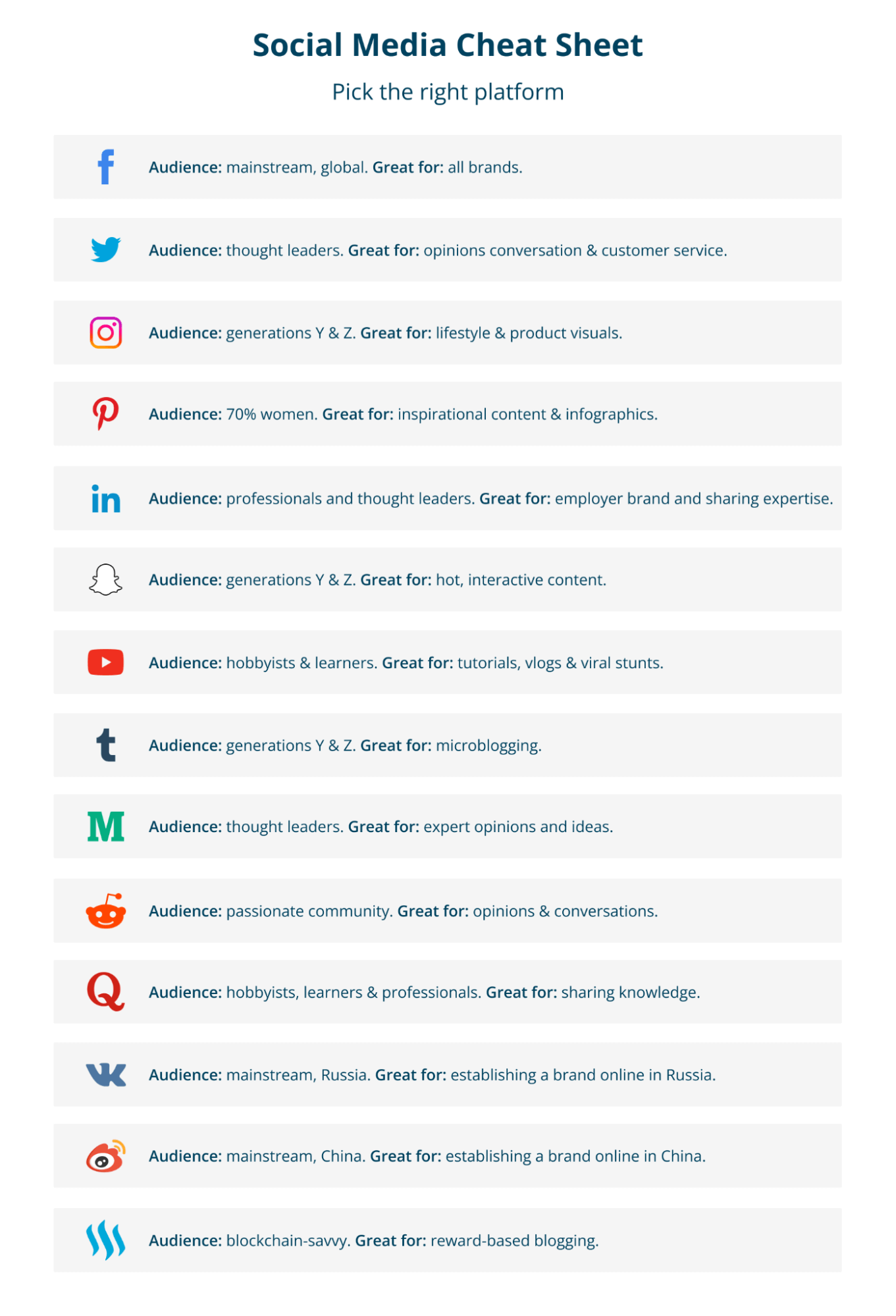10 Major Social Media Challenges for Marketers and How to Solve Them
As a social media marketing professional, you know full well that getting your brand’s voice heard and maintaining an engaged audience comes with endless challenges.
While some issues are straightforward — like ensuring there are no typos — others can derail entire social media campaigns or set you up for failure right from the start.
From picking the right social media platforms for each message and audience, to maintaining content quality, there are many hurdles successful marketers must overcome.
In this article, we’ll delve into the 10 biggest challenges for social media marketers and provide solutions to help you overcome them.
Quick links:
- Identifying the right platform
- Balancing multiple platforms
- Avoiding repetitive and poor-quality content
- Keeping goals and KPIs up to date
- Maintaining a consistent brand voice
- Avoiding stagnant or declining engagement rates
- Proving social media marketing value
- Working together with dispersed teams
- Overcoming time limitations
- Including graphics and videos that pop
#1. Identifying the right platforms
The Challenge: Deciding which social media platforms to run their campaigns on can be a headache for social media marketers.
There are so many major social media channels that are popular today and picking the right ones for your brand and products can be challenging.
But a misstep in this stage could lead to you focusing your efforts on the wrong audience, which consequently lead to ineffective campaigns and low audience engagement.
The Solution: To choose the most suitable platform for your brand, you must research your industry and target audience. Dig in to audience demographics, such as age, location, education and more to really understand them.
Some platforms, like Facebook and TikTok, are suitable for most companies. This explains why 90% of marketers used Facebook in 2022.
Besides popular social media platforms, you must also branch out into relevant channels for your brand’s target audience.
Here’s a handy cheat sheet to help you select the most relevant social media platforms:

The platform you choose will affect strategic decisions related to your campaigns and their performance.
#2. Balancing multiple platforms
The Challenge: Another massive problem that marketers run into is managing and creating content across multiple social accounts.
Since popular content styles vary from platform to platform, you can’t rely on a one-size-fits-all approach to content creation. You have to tailor your message to the unique features and culture of each platform, which is a huge task when running multiple campaigns.
Interacting with audiences, creating different types of content, catering to current social media trends, maintaining brand consistency, and monitoring campaigns also add to your seemingly never-ending workload.
The Solution: The best way to overcome this challenge is to use a social media management tool like Loomly to help you ‘localize’ your campaigns for each platform.
Social media management platforms, including Loomly, help provide a unified view of all your posts across multiple social media accounts in one place,
This overview enables you to plan and automate social media posting in advance to save time and improve efficiency.
Instead of juggling different tools to manage social campaigns, you can use automation and schedule posts to be published at the optimal time. This frees up your time to work on high-value tasks like new opportunities or collaborations.
For example, Ink and Olive Media saved time and improved their workflow using Loomly to effortlessly manage content for all their client’s social media accounts.
Loomly also keeps you updated on trending topics, so you can create relevant content.
#3. Avoiding repetitive and poor-quality content
The Challenge: We all know that good, high-quality content is vital for social media success. It helps build credibility and trust with your followers. Poor and repetitive content hinder growth, as audiences scroll past your posts without interest or engagement.
But, as a social media marketer, you know regularly posting quality content is easier said than done. Planning and creating content for different platforms while focusing on quality, trending topics, audience preferences and more is time-consuming and challenging.
The Solution: You can build a social media content plan and post consistently using tools like Loomly.
For example, Loomly’s Post Ideas feature can help you get fresh ideas and content themes for your social media posts using current Twitter trends, RSS Feeds, event and holiday-related celebrations and more.
Identifying relevant trends and holidays allows brands to join timely conversations, building trust and connection with their audience.
Loomly gives you all the research at your fingertips, so you can focus on creating engaging content that draws users in and keeps them hooked.
A social media calendar can also ensure you publish consistent and high-quality content by streamlining editorial processes. Good content also requires that you tailor content to each platform and regularly review and adjust marketing strategies based on data.
#4. Keeping goals and KPIs up to date
The Challenge: Many marketing campaigns are planned based on the goals they’re meant to achieve. When these goals and key performance indicators (KPIs) are outdated or irrelevant, it can be hard for your efforts to make a positive impact.
For example, outdated goals could lead to an increase in vanity metrics, like more followers, but this increase won’t reflect in the KPIs that matter to stakeholders, like leads and audience engagement.
Irrelevant goals could also lead to false expectations that hinder collaboration and reflect poorly on the overall marketing strategy.

The Solution: The best method to assess if your current goals are relevant and practical is to perform a social media audit.
This audit will help you get an in-depth look into your social media presence. You can understand and improve the different elements of your campaigns, including goals.
If the audit reveals that your goals are outdated, you can form new objectives using the information you have collected.
If your current goals are relevant, an audit can streamline existing processes and uncover new ideas to help reach KPIs.
#5. Maintaining a consistent brand voice
The Challenge: Your brand voice is integral to your brand identity. It’s one of the elements that lets audiences know what kind of company you are and the type of products you sell.
Essentially, it creates brand and product recognition.
Whether you use a formal business tone, common for B2B companies, or a casual style, like many B2C companies, consistent brand messaging across all channels is crucial.
A change in voice from one post to the next can confuse audience perception, reduce customer trust, and negatively impact your marketing efforts.
The Solution: You can use a publishing approval process as part of your marketing workflow to ensure brand consistency across all platforms.
This process is used to help marketing teams maintain the same voice and tone throughout all their social media posts.
You can also use a social media or editorial calendar to get an overview of your upcoming posts and check if they follow editorial guidelines. A calendar like this will speed up the approval process.
#6. Avoiding stagnant or declining engagement rates
The Challenge: Engagement is crucial for social media marketing as it helps build customer relationships and increases brand awareness.
When engagement rates are stagnant or declining, it indicates your campaign isn’t making the impact it should, and audiences aren’t connecting or interacting with your posts.
This makes algorithms less likely to expose your content to users and leads to a poor marketing return on investment (ROI).
The Solution: To increase engagement on social media, the first priority is to create fresh, interesting content for your audience.
You can complement this content with engagement-generating ideas like user-generated campaigns, polls, interviews, contests/ giveaways and visual lists. Responding promptly to user comments and messages can also build customer trust.
Strategic paid promotions and advertisements on social media can also help boost your campaign’s reach and potentially increase engagement.
#7. Proving social media marketing value
The Challenge: Proving the value of current campaigns to leadership and stakeholders is a key challenge for social media marketers.
Since leaders may not be familiar with more in-depth marketing metrics to measure success, they’re more likely to focus on sales and leads metrics.
This leaves you in a tough spot as you try to show why and how your social media marketing efforts are successful. The lack of concrete numbers can make it harder to prove social media ROI and secure funding for current and future campaigns.
The Solution: Tracking analytics can help you determine the effectiveness of your social media marketing efforts.
Besides tracking sales and click-throughs, you can use reporting features like Loomly’s Analytics to track post analytics to show that current social media campaigns are reaching their goals.
You can schedule automatic report generation on Loomly to collect data related to social media ROI, including engagement, click-throughs and conversions.
With this data, you can optimize current campaigns, show progress, and create effective future campaigns.
#8. Working together with dispersed teams
The Challenge: Whether you work in a marketing team or are an individual marketer with external clients, you know how difficult it is to effectively work together.
Differences in work methods, tools used, team hierarchy and communication styles can disrupt social media management, leading to poor content workflows and scattered marketing campaigns.
The Solution: Using a unified platform like Loomly can boost collaboration since it adds transparency to your social media efforts.
It allows everyone to communicate easily on a single platform and get on the same page about content.
For example, Loomly’s Post Mockups will show everyone on your team what a post will look like once live. So, you can stop sending 10 emails to get one post approved and invite everyone to your Loomly workspace instead.
Comments enable you to instantly give feedback and ask for changes to posts or schedules. Everyone working on the campaign can see these changes and add their own notes.
Loomly also maintains version logs, so every change and the person behind it is noted. This increases accountability.
Overall, using a social media management platform creates a more collaborative workflow.
#9. Overcoming time limitations
The Challenge: As a social media marketer, you know how hard time management is, given the number of platforms, accounts and tasks you must juggle.
You must manage content creation for multiple accounts while maintaining content quality standards, monitoring publishing deadlines, organizing assets, and strategizing.

The Solution: One solution to gain more time is to perform a social media audit to help you see where to focus the majority of your efforts.
Once that’s done, you can use social media tools to save time by speeding up and automating planning, scheduling, and posting.
Be My Social benefited greatly by using Loomly helped them with time management, with their Digital Marketing Manager Kai Savage, saying:
“Loomly has saved us about 2.5 hours per day for each of our employees vs. doing things manually.”
A social media tool that brings all your content onto one platform can streamline many processes involved in content creation and posting.
#10. Including graphics and videos that pop
The Challenge: On a related note, social media marketers are often expected to “wear multiple hats.”
Apart from publishing content, you’re asked to be experts in creating and managing assets like images and videos.
Designing, filming and editing videos and other assets is extremely time-consuming, and managing these tasks along with your already hectic workload can become tedious.
The Solution: The best way to tackle this challenge is to set clear expectations with all stakeholders from the start.
For example, you can list all the responsibilities you’ll handle and ask for external resources to work on additional tasks like video creation.
Organization also plays a big role in asset management. When working with video content creators and designers, you need a unified storage system like Loomly’s Content Library. This helps monitor which assets are complete and ensures everyone can access relevant files.
With an organized asset library, you can also easily repurpose existing images and videos for new posts.

Manage all your social media accounts in one place.
Craft, schedule, & auto-post content to all your social channels, then track analytics and manage interactions from a single, easy-to-use dashboard.
Conclusion
Social media marketers face many challenges when maintaining and increasing a brand’s social media presence.
You have the pressure of managing entire content calendars and assets for multiple accounts within limited time frames.
The tips listed above can help alleviate many common challenges you face, but organization and automation via social management tools like Loomly are critical to effectively running multiple social marketing campaigns.
Start your free trial today to experience the difference Loomly can make in streamlining your social media marketing.



